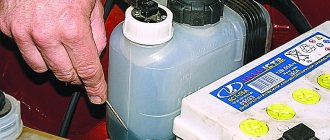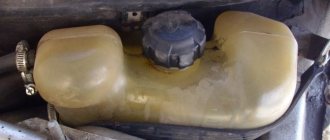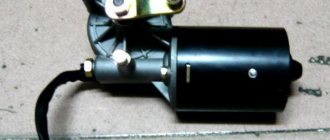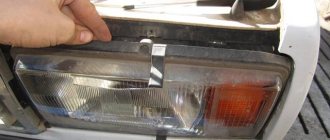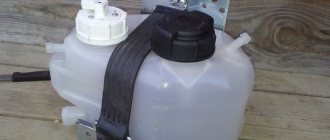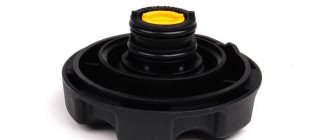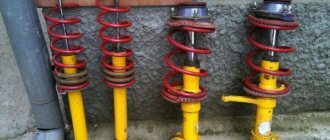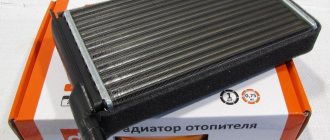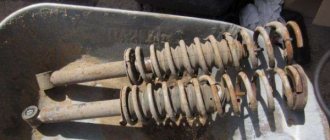01/26/2022 3,280 Electrical package
Author: Ivan Baranov
Every modern car is equipped with a washer system designed to clean the windshield and, depending on the car body, the rear window. This system includes various elements, including windshield wiper blades and a washer fluid reservoir (WHC) into which cleaning fluid is filled. Read more about what malfunctions the expansion tank is susceptible to and how to repair it.
[Hide]
How it works and where it is located
The tank is a plastic container.
Its shape resembles the most ordinary canister. You can pour anything into it. This can be ordinary water, or there may be special glass cleaning products.
The price for this container can range from 100 to 400 rubles. This different price is determined by the configuration. It can be equipped with a special motor that pumps liquid.
The VAZ washer reservoir is only part of a larger system. In addition to this reservoir, the design includes a pump that supplies liquid, a hose, a tee, windshield washer nozzles, a liquid level sensor, and fasteners.
The container is located under the hood, on the left. You can immediately see a large white plastic canister - that’s it.
To fill the container with water, you need to open the hood, unscrew the tank, and pour liquid to the required level. The standard tank capacity is about 5 liters.
How to change windshield washer fluid in a car
So, you have purchased anti-freeze windshield washer fluid, and you need to pour it into the reservoir. This procedure is not complicated, and you do not need to go to a service station - you can do the draining and filling yourself.
If you have never done this before, remember: the washer reservoir is located under the hood of the car (look for it on the left hand side in the headlight area). It is a small translucent/white container with a capacity of up to 3.5 liters with a blue, cyan, black or yellow lid, which can depict a windshield with a spraying washer.
You have to pour anti-freeze into it, but first you should check whether there is liquid in it, and if there is, then drain it.
How to drain liquid from the tank
Replacing water or fluid in the washer reservoir in the warm season is simple: water or weak anti-freeze can be completely used up by operating the steering column lever. The pump will blow all the liquid out of the system and reservoir. But this method is good if the tank is minimally filled: there is no need to put heavy loads on the washer pump electric motor!
If the tank is full (up to 3.5 liters in the tank + 1.5 liters in the line system), the liquid should be drained forcibly. There are several options for forced draining:
- You can blow it out of the system and empty the tank with an air compressor (the pump tube is connected to the windshield washer system, and the compressed air is turned on).
- You can drain the liquid through the windshield washer hose, which is disconnected from the nozzle and lowered into a drain container. After this, the windshield washer motor is turned on, and liquid under pressure is pumped out of the tank.
- You can unscrew the washer motor and drain the liquid through the resulting hole (but only if access to the motor is convenient).
If access to the hoses and washer motor is difficult (on some brands of cars this is really difficult), you can pump out the liquid from the reservoir using the simplest method - a rubber bulb with an elongated spout or a large syringe with a tube. Then all that remains is to expel the remaining fluid from the lines and injectors, using the steering column lever.
How to fill liquid
After the water or old windshield washer fluid has been drained, you can begin to fill in the new anti-freeze agent. It's simple: you need to remove the cap from the bottle and slowly pour the required amount of liquid into the neck of the tank. For convenience, you can use a large watering can.
When pouring, try not to splash the liquid past - there are electrical wiring and headlights nearby, which can short out if liquids get in. It is also important that the antifreeze does not spill onto the drive belt - this will worsen its technical characteristics.
In the same way, you can add windshield washer fluid when it is used up, or pour hot water into the anti-freeze tank if it freezes in the tank.
Important! After the liquid has been added, pump the windshield washer motor lever a little so that the anti-freeze agent flows into the system. It is also recommended to bleed the pipelines and nozzles before pouring any liquid into an empty tank - it is necessary to prevent the formation of air pockets or old water.
Typical problems that can happen
Often, during the change of seasons, car enthusiasts manage to do everything to prepare their cars for the winter cold.
So, the oil is changed, the tires are changed. And many people forget to empty the washer reservoir. Then frosts come, the water in it freezes, the system depressurizes, and the pump may fail due to ice. But this is just a theory. Most often, a crack appears on the body of this very tank, which in winter can turn into a large crack. There are many more different reasons why these plastic containers fail.
Frequent unit malfunctions
The container for antifreeze liquid does not require maintenance during vehicle operation, but malfunctions may occur that require repair or complete replacement of the product. It is necessary to contact car service specialists in the following situations:
- If cracks have formed in the tank body.
- The seal of the product was broken and leaks began to form.
- The threaded connection is not tight enough, which can also lead to leaks.
- If the water freezes, the unit in this case becomes completely inoperable.
- Electric motor failure. Such a malfunction leads to a decrease in pressure, and the product will reach the nozzles in insufficient quantities or will not flow at all.
Replacing the windshield washer reservoir
If suddenly for some reason there is a need to replace the tank, it is very easy to do it yourself. No special skills or tools are required here. All work can be done with almost bare hands.
Before removing the windshield washer reservoir, be sure to disconnect the hose and power cables from the motor and level sensor. Then use a 10mm socket to remove the bolts that secure the reservoir to the slots. Now this part will come off easily if you pull it up.
Don't forget to remove the electric pumps from the tank. The sealing sleeve can be easily pryed with a screwdriver and removed from its seat. If this part is no longer flexible or has any damage, it should be replaced.
After this, you need to remove the level sensor from the tank. To do this, you must unscrew the plug and remove the sensor. Now all work is completely finished.
What you need to know when replacing a windshield washer
Maintaining the windshield washer system does not require much effort, but it is better to monitor and service it regularly to prevent blockages, traffic jams or ice from appearing in the winter. Important to remember:
- The system should be pumped periodically to remove air and water from it. This should be done before each new anti-freeze fill.
- There should always be a container with 3-4 liters of windshield washer fluid in the trunk to top it up if the reservoir is empty in the middle of the road.
- There is no need to fill the washer reservoir to the top. If the anti-freeze suddenly freezes, you should have room in the tank to add hot water, alcohol or anti-freeze concentrate to melt the ice.
- Antifreeze concentrate can be diluted if there is no serious frost or thaw outside, but the liquid and water should be mixed not in a tank, but in a separate container. This way you will protect the system from accidental incompatibility of components and will be able to control the concentration of the finished solution.
- If you accidentally poured low-quality anti-freeze into the tank, you should drain it completely. If you poured in a liquid with an inappropriate freezing point, you can simply add concentrate.
In conclusion, it should be noted that draining and filling windshield washer fluid in a car is a simple procedure that you can handle without outside help. In winter, replacing a windshield washer is more difficult, as there is a risk of freezing the liquid in the reservoir and pipelines, damaging the washer pump, or breaking the system's electric motor. Therefore, it is important to carry out all stages of work consistently and carefully.
Be sure to pay attention to the quality, characteristics, freezing point and seasonality of the windshield washer fluid, do not leave water in the windshield washer lines and do not let the system freeze in the cold.
Washer reservoirs: repair
If your tank suddenly develops a crack for unknown or known reasons, you have several options. Either it’s a repair or buying a new container, since its price is low. If you are on the highway, then definitely a repair.
If temporary measures are needed, then prepare several food bags and place the washer reservoir in them. This will stop the water leakage for a while. It is advisable that these bags are approximately the same size as your container.
You can also perform simple repairs using a soldering iron. For such repairs you will need an ordinary soldering iron. It needs to be cleaned, but there is no need to tin it. Use a plastic food bag as solder. Twist it to make a rope with a diameter of 5 mm. Solder one end of it below the crack, and then slowly solder the entire crack and even a little higher.
Be careful not to overheat the soldering iron. Then heat the tourniquet until it becomes transparent, but heat it carefully so as not to damage the tank body. After cooling, you will get a reliable seam.
The nuances of operating the device “by season”
What you need to know about operation:
- In the warm season, it is allowed to use a washing solution or water with the addition of a special additive.
- In winter, you need to fill in a special anti-freeze liquid, since the water can freeze and ruin the container itself. You can find the appropriate fluids in domestic auto stores.
- Use heated washer fluid reservoir. As practice shows, most cases of cracks in tanks are due to consumables freezing in them. To prevent this, you can use a heated washer reservoir, which is installed on cars as standard or as additional equipment.
Lada Priora washer reservoir
These cars have very fragile tanks.
They are made of simply terrible plastic. Sometimes they often crack right along the seam. Repairing it is unprofitable and much easier to replace.
There are many different offers in the stores. So, you can use a model for two pumps. This way you can ensure the glass is clean both front and back. This container has a slightly larger volume when compared with that installed by the manufacturer.
It is also much better made.
When replacing, you need to take into account that on the Lada Priora in hatchback and station wagon bodies, you buy containers for two pumps. If you have a sedan, then this option will not suit you.
Removing the tank
At the first stage, the liquid is drained from the reservoir. Then you need to disconnect the terminals from the battery. To do this, you can use a 10mm wrench. The stand to which the tank is attached can be unscrewed with a 13mm wrench. Work as carefully as possible, otherwise you will drop the nut. After this, you need to dismantle the battery. If there is an air conditioner, remove the air conditioner mounting block as well.
Before removing pumps from the reservoir, prepare a large amount of rags. Near the optics, unscrew the nuts that secure the container to the stand. Now you can remove the old element and install the new one. Now you know how to remove the washer reservoir.
